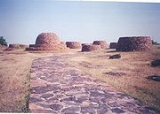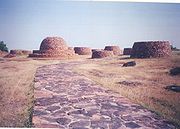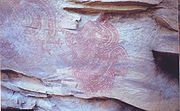
Deur Kothar
Encyclopedia



: देउर कोठार, also Deur Kothar) is a location of archeological importance in Madhya Pradesh
Madhya Pradesh
Madhya Pradesh , often called the Heart of India, is a state in central India. Its capital is Bhopal and Indore is the largest city....
, Central India. It is known for its Buddhist stupa
Stupa
A stupa is a mound-like structure containing Buddhist relics, typically the remains of Buddha, used by Buddhists as a place of worship....
s and was discovered in 1982.These stupas are credited to Mauryan emperor Ashoka the great.
Location
It is situated about 5 km north-west of village Katra in Rewa districtRewa District
Rewa District is a district of Madhya Pradesh state in central India. The city Rewa is the district headquarters. Rewa is also known as land of white tigers.-Geography:...
at a distance of 75 km from Rewa on Rewa
Rewa, India
Rewa is formerly the capital of the princely state of Rewa and former state of Vindhya Pradesh in central India. It is an important city in the North Eastern part of Madhya Pradesh state of India bordering Allahabad, Mirzapur and Banda Districts of Uttar Pradesh and Satna and Sidhi Districts of...
– Allahabad
Allahabad
Allahabad , or Settled by God in Persian, is a major city of India and is one of the main holy cities of Hinduism. It was renamed by the Mughals from the ancient name of Prayaga , and is by some accounts the second-oldest city in India. It is located in the north Indian state of Uttar Pradesh,...
Road. Deorkothar village is located at Longitude
Longitude
Longitude is a geographic coordinate that specifies the east-west position of a point on the Earth's surface. It is an angular measurement, usually expressed in degrees, minutes and seconds, and denoted by the Greek letter lambda ....
81°40' East and Latitude
Latitude
In geography, the latitude of a location on the Earth is the angular distance of that location south or north of the Equator. The latitude is an angle, and is usually measured in degrees . The equator has a latitude of 0°, the North pole has a latitude of 90° north , and the South pole has a...
24°56' North in Tyonthar tehsil of Rewa district
Rewa District
Rewa District is a district of Madhya Pradesh state in central India. The city Rewa is the district headquarters. Rewa is also known as land of white tigers.-Geography:...
. The Deur Kothar stupa may have been established by the Maurya king Asoka in the 3rd century BCE. In the ancient times, the site was located on the Dakshinapatha
Dakshinapatha
Ancient Buddhist and Hindu texts use the term Dakshinapatha as a name for both the southern high road of the Indian subcontinent, and for the region lying south of Majjhimdesa or middle India. It is derived from the two Sanskrit roots dakshina for south, and patha for road.The first reference to...
(Southern Trade Route) running east-west from Patliputra
Patliputra
Pāṭaliputra , modern-day Patna, was a city in ancient India, originally built by Ajatashatru in 490 BC as a small fort near the River Ganges, and later the capital of the ancient Mahājanapadas kingdom of Magadha....
(Patna) to Pratishthana in Maharashtra
Maharashtra
Maharashtra is a state located in India. It is the second most populous after Uttar Pradesh and third largest state by area in India...
through Central India. Being situated centrally amongst the famous Buddhist places like Sanchi
Sanchi
Sanchi is a small village in Raisen District of the state of Madhya Pradesh, India, it is located 46 km north east of Bhopal, and 10 km from Besnagar and Vidisha in the central part of the state of Madhya Pradesh. It is the location of several Buddhist monuments dating from the 3rd...
, Sagar, Kaushambi and Sarnath
Sarnath
Sarnath or Sārnātha is the deer park where Gautama Buddha first taught the Dharma, and where the Buddhist Sangha came into existence through the enlightenment of Kondanna. Sarnath is located 13 kilometres north-east of Varanasi, in Uttar Pradesh, India...
, Deur Kothar used to be visited by Bhuddhist monks frequently.
The discovery and excavations
P.K. Mishra (Archaeological Survey of IndiaArchaeological Survey of India
The Archaeological Survey of India is a department of the Government of India, attached to the Ministry of Culture . The ASI is responsible for archaeological studies and the preservation of archaeological heritage of the country in accordance with the various acts of the Indian Parliament...
) discovered Deorkothar in 1982 along with Ajit Singh, sarpanch
Sarpanch
A sarpanch is a democratically elected head of a village level statutory institution of local self-government called the gram panchayat in India and Pakistan. He, together with other elected Panchas , constitute the Gram Panchayat. The Sarpanch is the focal point of contact between government...
of village Barhat. It was declared a monument of national importance in 1988 by the Govt of India and is being preserved and conserved by Archaeological Survey of India
Archaeological Survey of India
The Archaeological Survey of India is a department of the Government of India, attached to the Ministry of Culture . The ASI is responsible for archaeological studies and the preservation of archaeological heritage of the country in accordance with the various acts of the Indian Parliament...
, Bhopal.
Realising the importance of the site, and its likely international bearing on Buddhism, the Archaeological Survey of India decided to carry out extensive, but controlled, excavations at the site. The excavations were started at the site in 1999 and continued up to 2000. The site is marked by four stupa mounds out of which two stupas No. 1 and 2 were subjected to archaeological excavations. There are remnants of 40 stupas made of stones or bricks. In the area around there are rocks with old rock paintings. Some rocks have inscriptions in Brahmi
Brāhmī script
Brāhmī is the modern name given to the oldest members of the Brahmic family of scripts. The best-known Brāhmī inscriptions are the rock-cut edicts of Ashoka in north-central India, dated to the 3rd century BCE. These are traditionally considered to be early known examples of Brāhmī writing...
language.
The Buddhist firmament is abuzz with word of amazing discoveries at the newly excavated site of Deorkothar in Madhya Pradesh, India. Situated on the ancient Dakshinapath (southern trade route), Deorkothar lies between Bharhut
Bharhut
Bharhut or Barhut , is a location in Satna district in Madhya Pradesh, Central India, known for its famous Buddhist stupa. The Bharhut stupa may have been established by the Maurya king Asoka in the 3rd century BCE, but many works of art were apparently added during the Sunga period, with many...
and Sanchi
Sanchi
Sanchi is a small village in Raisen District of the state of Madhya Pradesh, India, it is located 46 km north east of Bhopal, and 10 km from Besnagar and Vidisha in the central part of the state of Madhya Pradesh. It is the location of several Buddhist monuments dating from the 3rd...
, two major Buddhist centers established in the third century BC. It is surprising that Alexander Cunningham
Alexander Cunningham
Sir Alexander Cunningham KCIE CSI was a British archaeologist and army engineer, known as the father of the Archaeological Survey of India...
, the nineteenth-century doyen of Indian archaeology who did extensive work in the area, missed the site. Excavations at Deorkothar, which seems to predate the late Mauryan-Sunga period (fourth through first centuries B.C.), when most early stupa (temple) complexes were built, promise to throw light on the genesis and spread of Buddhism in Central India, providing missing links in the history of Buddhist art and architecture.
Architecture
The Deorkothar complex boasts four brick stupas, the most ever found at a site of this period. The varying sizes of bricks used in construction point to an early date. Such motifs as twirling lotus, conical lotus bud, and a simple flower pot on a three-tiered pedestal-the carving of which foreshadows early Buddhist art, can be seen on the railing posts of the largest brick stupa, which rises to a height of nearly 30 feet. The stencil-cut effect of the friezes, along with their simple ornamentation and the paucity of human and animal figures, suggests these are early attempts at stone railing art. It would therefore seem that the stupa at Deorkothar was built before the famous early free-standing stupa at SanchiSanchi
Sanchi is a small village in Raisen District of the state of Madhya Pradesh, India, it is located 46 km north east of Bhopal, and 10 km from Besnagar and Vidisha in the central part of the state of Madhya Pradesh. It is the location of several Buddhist monuments dating from the 3rd...
.
The site of Deorkothar also comprises monasteries, a water channel system, an ancient pathway, and 30 stone stupas, many of which contained sherds of high quality northern black polished ware, the pottery of everyday use between 700 and 300 B.C. Such sherds are absent from Sanchi, further indicating that Deorkothar predates that site.
Dotting the site of Deorkothar are 63 rock-shelters, many with art dating to the first century B.C., that were likely used by monks for meditation. One painting depicts a stupa and a tree surrounded by a railing. Others show social or hunting scenes; men, women, and animals; weapons; and designs.
Although the pillar bears the trademark Mauryan polish, it is made not of the Chunar sandstone characteristic of Ashokan sculpture, but of local sandstone. Also found at the site were pottery, pieces of stone caskets and bangles with exquisite polish, some copper fragments, a lead strip coiled ear stud, iron nails and clamps, few coins (one punch-marked), pieces of terra-cotta toys, and beads. Worthy of particular mention are several pieces of Mauryan polished chattra (the multi-tiered "umbrella" at the top of a stupa) with evidence of radial ribs. To the west of the main stupa, iron slag, a lump of iron ore, and white nodules of lime indicate the presence of an iron-smelting furnace nearby.
Deorkothar inscription
Also recovered pieces of a pillar with a six-line inscription in BrahmiBrāhmī script
Brāhmī is the modern name given to the oldest members of the Brahmic family of scripts. The best-known Brāhmī inscriptions are the rock-cut edicts of Ashoka in north-central India, dated to the 3rd century BCE. These are traditionally considered to be early known examples of Brāhmī writing...
, the precursor to modern Indian alphabets, the earliest examples of which date to the rule of the Mauryan empire, Ashoka
Ashoka
Ashok Maurya or Ashoka , popularly known as Ashoka the Great, was an Indian emperor of the Maurya Dynasty who ruled almost all of the Indian subcontinent from ca. 269 BC to 232 BC. One of India's greatest emperors, Ashoka reigned over most of present-day India after a number of military conquests...
(273 BC-232 BC).
The six line Brahmi
Brāhmī script
Brāhmī is the modern name given to the oldest members of the Brahmic family of scripts. The best-known Brāhmī inscriptions are the rock-cut edicts of Ashoka in north-central India, dated to the 3rd century BCE. These are traditionally considered to be early known examples of Brāhmī writing...
inscription on the Deorkothar pillar is given below - transliterated into Devanagari
Devanagari
Devanagari |deva]]" and "nāgarī" ), also called Nagari , is an abugida alphabet of India and Nepal...
script:
भ ग व तो बु ध
उ त र मि त्रो उ त र मि त्र स अ
भ ड् भ ड् स आ ते वा सि ना दि नु
उ पा स क स आ ते वा सि स व ज य स व
ध म द वे न के क डी के न ब स ति ये
उ स पि तो भं भो आ आ च रि ये न क सि
In brief, the translation of the aforesaid inscription at Deokothar is as follows:
- "The inscription opens up with Lord BuddhaGautama BuddhaSiddhārtha Gautama was a spiritual teacher from the Indian subcontinent, on whose teachings Buddhism was founded. In most Buddhist traditions, he is regarded as the Supreme Buddha Siddhārtha Gautama (Sanskrit: सिद्धार्थ गौतम; Pali: Siddhattha Gotama) was a spiritual teacher from the Indian...
as first line of the inscription clearly suggests. The gist of the inscription, pertains to the erection and dedication of stone pillar at place by UpasakaUpasakaUpāsaka or Upāsikā are from the Sanskrit and Pāli words for "attendant". This is the title of followers of Buddhism who are not monks, nuns, or novice monastics in a Buddhist order, and who undertake certain vows...
and his disciplines in memory of Buddha, the enlightened one."
The inscription speaks about an Acharya
Acharya
In Indian religions and society, an acharya is a guide or instructor in religious matters; founder, or leader of a sect; or a highly learned man or a title affixed to the names of learned men...
, named Dharamdev, and his three disciplines - Uttarmitra, Bhadra
Bhadra
In Hinduism, Bhadra is a goddess of the hunt and one of Shiva's servants....
and Upasaka
Upasaka
Upāsaka or Upāsikā are from the Sanskrit and Pāli words for "attendant". This is the title of followers of Buddhism who are not monks, nuns, or novice monastics in a Buddhist order, and who undertake certain vows...
, who used to reside in the monastery. They installed this pillar, dedicating it to the Buddha.
Active trade centre
The discovery of pieces of terracotta toys, beads, ear stud and coins hints that the site was an active centre of trade. Perhaps, the genesis of this pilgrimage site occurred amidst a vibrant mercantile community.Curiously, the ancient tradition of lime technology noticed from some Harappan and post-Harappan sites besides Kausambi has now been observed at Deorkothar. The excavations have thrown significant light on the art and technological excellence of Deorkothar.
Subjected to destruction
The ancient Buddhist text Divy Adanam speaks of the death and destruction brought about by Pushyamitra Sunga, who ruled in the first quarter of the second century B.C., in a bid to glorify HinduismHinduism
Hinduism is the predominant and indigenous religious tradition of the Indian Subcontinent. Hinduism is known to its followers as , amongst many other expressions...
. During his reign, Buddhist monuments were wantonly destroyed. This Mauryan pillar lay in more than fifty pieces directly on the flagstone flooring along with the balustrades broken into smithereens. Even the chhatra (umbrella) lay in the rubble of systematic annihilation. The devastation continued on the brick body of the stupa which is understood by the brickbat debris uniformly overlying the fragments of the balustrade. This wanton destruction has been temporarily assigned to the first quarter of the 2nd century BC. Although archaeological evidence is meager in this regard, it seems likely that the Deorkothar stupa was destroyed as a result of Pushyamitra Sunga's fanaticism. The exposed remains at Deorkothar bear evidence of deliberate destruction datable to his reign. The three-tiered railing is damaged; railing pillars lie, broken to smithereens, on stone flooring. Twenty pieces of pillar have been recovered, each fragment itself fractured. The site offers no indication of natural destruction.
See also
- Decline of Buddhism in IndiaDecline of Buddhism in IndiaThe decline of Buddhism in India, the land of its birth, occurred for a variety of reasons, and happened even as it continued to flourish beyond the frontiers of India. Buddhism was established in the area of ancient Magadha and Kosala by Gautama Buddha in the 6th century BCE, in what is now modern...
- Buddhism in India
- Buddhist architectureBuddhist architectureBuddhist religious architecture developed in South Asia in the 3rd century BC.Three types of structures are associated with the religious architecture of early Buddhism: monasteries , stupas, and temples ....
- BharhutBharhutBharhut or Barhut , is a location in Satna district in Madhya Pradesh, Central India, known for its famous Buddhist stupa. The Bharhut stupa may have been established by the Maurya king Asoka in the 3rd century BCE, but many works of art were apparently added during the Sunga period, with many...
- SanchiSanchiSanchi is a small village in Raisen District of the state of Madhya Pradesh, India, it is located 46 km north east of Bhopal, and 10 km from Besnagar and Vidisha in the central part of the state of Madhya Pradesh. It is the location of several Buddhist monuments dating from the 3rd...

